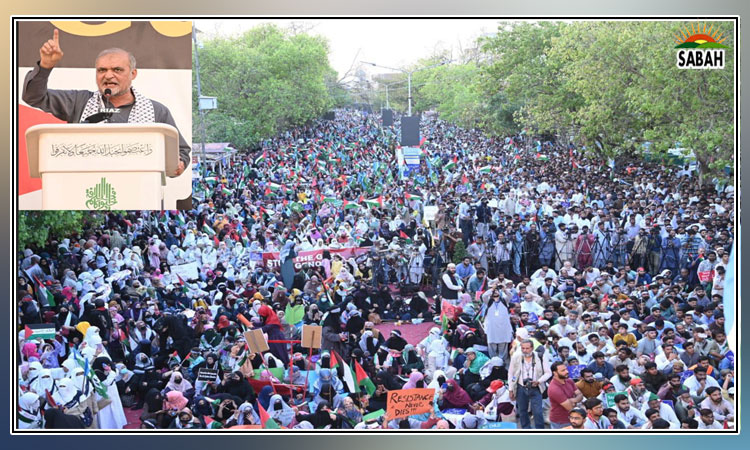Judicial chaos…Khwaja Ahmad Hosain
WHEN a society and its institutions cannot agree on basic rules, it signifies a breakdown that requires serious introspection. A simple issue which is clearly dealt with in a written Constitution has been unnecessarily complicated. This is a reflection of where we stand as a nation. Dangerously divided. With all institutions shorn of credibility.
Differences of opinion have become moral crusades. Each side claims support from divine command. Slowly, but surely, we are destroying any prospects for a better future.
The Constitution clearly provides elections must be held within 90 days of the dissolution of a provincial assembly. All relevant stakeholders had a constitutional duty to ensure compliance with this command. Rather than cooperate, everyone started to pass the buck.
The governors and the federal government shrugged their shoulders and said this was a matter for the Election Commission of Pakistan. The ECP said they could not set any date. The president was too eager to please his party and fixed a date for the election to the KP Assembly. He later conceded he had no authority to do so.
A two-member bench of the Supreme Court hearing a case related to the powers of a caretaker government to transfer officials was concerned about this imminent breach of a constitutional deadline for elections. It requested the chief justice of Pakistan to take suo motu notice.
The CJP acted and constituted a nine-member bench to consider this significant matter. Once a bench is constituted and starts hearing a matter, the CJP does not have the unilateral power to change or reconstitute it through the exercise of his administrative discretion.
When the bench convened, there were serious reservations expressed by four of its members regarding its composition and the suo motu action. Justice Afridi (with whom Justice Minallah agreed) dismissed all three petitions pending before the bench. This was a minority opinion. He left it to the chief justice to decide whether to retain him in the present bench but noted it would be of no avail.
The nine-member bench passed an order where they referred the matter to the CJP for reconstitution of the bench. The reason for this action as expressed in this unanimous order was the additional notes attached by the four judges who had reservations.
Since this was the reason, one would expect the CJP to pass an order explaining his reasons for assigning the case to the five judges whom he made part of the reconstituted bench. No such order is available in the public domain.
Although bench constitution is a matter for the CJP, in this case his brother judges had raised certain specific concerns regarding the composition of the bench in written additional notes. In the interests of comity among the judges, the CJP should have considered and explained through an order his reasons for converting a matter which he considered initially important enough to be heard by nine judges to one which should be heard by five. He should also have explained why certain senior judges were excluded. Failure to do so diminished his office and his institution.
The five-member reconstituted bench heard the matter and allowed the petitions by a majority of three to two. The law minister and PTI both claimed victory. Imran Khan came on television and said that this was the first step to Pakistan becoming a great country governed by laws rather than men. He said the same thing after he won the Panama case. That was a false dawn.
The present situation is confusing and patently unsatisfactory. Initially, a nine-member bench passed an order with four additional notes. In these additional notes, two judges dismissed the petitions. They were not made part of the reconstituted bench. Subsequently, a reconstituted five-member bench heard the same matter. Two out of these five judges dismissed the petitions for the same reasons. Three judges allowed the petitions.
It is clear that the majority order of the reconstituted five-member bench is the order of the CJP allowing the petitions. The government is wrong to say they have won the case four-three. The five-member bench was a different and reconstituted bench.
The dismissal decision by the two judges who were part of the nine-member bench are not decisions of the reconstituted bench. Justice Shah in the footnote to his opinion has stated that the dismissal decisions of these two judges form part of the record of this case. This does not mean that those decisions are decisions of the reconstituted bench.
Nothing turns on Justice Shah classifying his opinion as an order or stating that he agrees with the dismissal orders of the judges of the nine-member bench. A minority opinion does not become a majority one if the minority labels it as an order.
The net result is seven judges have, within the space of a few days, decided the same matter as part of two separate benches. Four have dismissed the petitions. Three have allowed them. Because of the reconstitution of the bench by the CJP, the opinion of the three judges constitutes the decision of the court.
Although the CJP highlights the importance of parliamentary democracy in his majority opinion, there is clearly no such democracy within his court. A judicial result with far-reaching implications has been determined by an administrative order of the CJP reconstituting the bench.
This needless controversy could have been easily avoided. The CJP should have constituted a full court of eligible judges. The hearings only lasted for two days and would not have consumed excessive judicial time. Rather than resolving the dispute before it, the court has created more confusion. It may need to clarify not only what it said but also what it meant.
Courtesy Dawn











